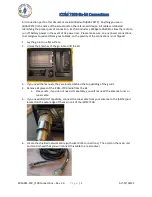
15
10.
Nuisance Delete
Pressing this key deletes the current channel that has activity. If the radio is scanning and
is not stopped at a channel then this key does nothing.
The purpose of this key is to delete scan channels that have noise on them or other
erroneous transmissions. This prevents the scanning from always stopping at a channel
that has no meaning. Once you quit the scan mode and then enable it again this deleted
channels comes back. You cannot delete a priority channel from the scan list.
11.
Hi-Low Power Switch
This alternate action switch selects between high power and low power.
By selecting low power you minimize the radio frequency energy and the magnetic
energy from the radio. It also helps in battery life and it prevents people far away from
hearing you.
12.
Monitor Momentary
Pressing this switch enables the user to hear all activity. Releasing the switch puts the
radio back in normal mode and only the radio messages with the proper CTCSS or DCS
code will be heard.
Normally the user will only hear messages with the proper CTCSS or DCS codes. This is
to prevent the user from fatigue by hearing all messages sent to everybody. This switch
bypasses that protection and allows the user to hear all traffic on that channel as long as
the key is pressed.
13.
Monitor On/Off
This is an alternate action switch. Pressing the key the first time enables the Monitor
mode and pressing it again disables the Monitor mode. When it is enabled, all the activity
on that channel will be heard. will. When it is disabled, only the activity with the proper
CTCSS or DCS codes will be heard.
The technician who is trying to maintain the system mostly uses this feature. It allows the
technician to hear all the traffic on the channel and determine where there are problems.
14.
Squelch Off Momentary
Pressing this switch disables the squelch and allows the user to hear the weakest signal
possible. Releasing the switch puts the radio back in normal mode and only a message
with the proper CTCSS or DCS code will be heard.
By turning off the squelch the user can hear a weaker signal than if the squelch was
already enabled. This is both a diagnostic tool and a feature. If the transmitter from the
originating user is weak and does not get past the squelch, then disabling the squelch will
allow the user to hear weak signals.


































